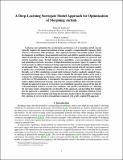A Deep-Learning Surrogate Model Approach for Optimization of Morphing Airfoils
Author(s)
Karbasian, Hamidreza; van Rees, Wim M.
DownloadAccepted version (2.308Mb)
Open Access Policy
Open Access Policy
Creative Commons Attribution-Noncommercial-Share Alike
Terms of use
Metadata
Show full item recordAbstract
Analyzing and optimizing the aerodynamic performance of a morphing airfoil concept typically requires the numerical solution of many complex, computationally expensive fluid-structure interaction (FSI) problems. This approach becomes intractable against current developments in intelligent, programmable materials and additive manufacturing techniques, which drastically increase the design space and open novel opportunities for passively and actively morphing wings. To fully exploit these capabilities, a new paradigm for analyzing and optimizing aeroelastic structures in high-dimensional parameter spaces is required. This work presents an efficient numerical design approach for elastically morphing structures in aerodynamic flows. Our approach centers on using deep neural network surrogate models to predict the aerodynamic loading as a function of a given shape. The models are trained through a set of flow simulations around rigid stationary bodies randomly sampled from a parametrized design space of the shapes. Once trained, the surrogate model can be used to evaluate the aerodynamic performance of any structural design without the need for further costly flow or FSI simulations. Consequently, this approach can analyze and optimize airfoils within a higher-dimensional structure and structure-actuator problems than currently possible. Though the approach is general, we focus here on establishing a proof-of-concept of this idea for a 2D multi-hinged airfoil at a steady-state condition. The specific contributions are validating the surrogate model, estimating the cost benefits of this approach, and providing first insights into the approach's capabilities. A practical optimization of a 2D morphing airfoil in steady flows demonstrates that training and using the surrogate model reduces the number of required flow solutions by several orders of magnitude compared with a fully coupled FSI approach.
Description
AIAA SCITECH 2023 Forum 23-27 January 2023 National Harbor, MD & Online
Date issued
2023-01-19Department
Massachusetts Institute of Technology. Department of Mechanical EngineeringPublisher
American Institute of Aeronautics and Astronautics
Citation
Hamidreza Karbasian and Wim M. van Rees. "A Deep-Learning Surrogate Model Approach for Optimization of Morphing Airfoils," AIAA 2023-1619. AIAA SCITECH 2023 Forum. January 2023.
Version: Author's final manuscript